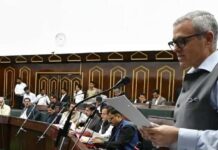Union Budget 2025: Key Highlights and Sector-wise Comparison with Previous Budget
Report by Sahil Aggarwal
(Editor-in-Chief Views Today)
Jammu, Feb 03, 2025: The Union Budget 2025-26, presented by Finance Minister Nirmala Sitharaman, marks a significant step in India’s journey toward strengthening its economy and enhancing the welfare of its citizens. With a focus on sustainable growth, digital transformation, and boosting key sectors, the budget emphasizes a balance between economic development and social welfare. In this article, we’ll provide key highlights of the Union Budget 2025 sector-wise and compare them with the provisions of the 2024 budget.
1. Agriculture and Rural Development
Key Highlights of Union Budget 2025:
- Farmers’ Welfare: The “PM Kisan Samman Nidhi” has been further enhanced with additional provisions for farmers, focusing on easy access to credit and insurance.
- Sustainable Agriculture Initiatives: The Union Budget 2025 promotes climate-resilient farming practices, including developing drought-resistant crops and enhancing the irrigation infrastructure under the National Mission for Sustainable Agriculture.
- Rural Infrastructure: The allocation for rural infrastructure has been increased, including better road connectivity, rural electrification, and water management under the Pradhan Mantri Krishi Sinchayee Yojana (PMKSY).
Comparison with Budget 2024:
- While the 2024 budget also focused on agriculture, the emphasis was more on digitization and fintech solutions for farmers. The increased focus on climate resilience in the 2025 budget marks a significant shift towards sustainable agricultural practices.
- The rural infrastructure allocation has seen a significant hike in 2025, compared to the previous year’s budget, reflecting the government’s focus on rural upliftment and improving basic facilities.
2. Healthcare and Social Welfare
Key Highlights of Union Budget 2025:
- Health Infrastructure: A substantial increase in funding for the National Health Mission, with a focus on improving healthcare facilities in remote areas.
- Ayushman Bharat: Expansion of the Ayushman Bharat scheme to cover more citizens, offering universal health coverage for all.
- Social Security: Focus on ensuring pension coverage and health insurance for the elderly and marginalized groups.
Comparison with Budget 2024:
- The 2025 budget places a more comprehensive focus on social security for the elderly, which was somewhat limited in the 2024 budget.
- The expansion of Ayushman Bharat in 2025 reflects the government’s priority to make healthcare more inclusive compared to the 2024 initiatives which were more focused on primary healthcare centers.
3. Infrastructure and Urban Development
Key Highlights of Union Budget 2025:
- National Infrastructure Pipeline (NIP): Continued push for the National Infrastructure Pipeline, with an emphasis on the development of smart cities, rural roads, and metro systems.
- Affordable Housing: Increased allocation for affordable housing projects under the Pradhan Mantri Awas Yojana (PMAY) to ensure “Housing for All.”
- Sustainable Infrastructure: More focus on the Green Energy Corridor and Smart City development under the national policy on urbanization.
Comparison with Budget 2024:
- Both the 2024 and 2025 budgets emphasize infrastructure development, but the 2025 budget is more focused on integrating sustainability into infrastructure, especially with green energy projects and sustainable urban planning.
- The 2025 budget introduces incentives for private-public partnerships (PPPs) in urban development projects, something that was not as prevalent in the 2024 budget.
4. Education and Skill Development
Key Highlights of Union Budget 2025:
- Digital Learning: Increased allocation for digital education platforms, with an emphasis on upskilling youth for emerging sectors like AI and machine learning.
- Higher Education: Boost research and innovation in higher education institutions, with funds for scholarships and faculty development programs.
- Skilling Programs: Strengthening of skill development initiatives to create a more job-ready workforce under the Pradhan Mantri Kaushal Vikas Yojana (PMKVY).
Comparison with Budget 2024:
- The 2025 budget introduces a more expansive focus on digital learning, marking a shift from last year’s emphasis on physical infrastructure in education.
- While skill development was already a priority in 2024, the 2025 budget has a deeper focus on sector-specific skills, addressing emerging industries.
5. Defence and National Security
Key Highlights of Union Budget 2025:
- Defense Modernization: Allocation for defense modernization and procurement of Indigenous military equipment.
- Cybersecurity: Enhanced budget for national cybersecurity initiatives to counter growing threats in the digital age.
- Veteran Welfare: Increased funding for ex-servicemen welfare schemes and rehabilitation programs.
Comparison with Budget 2024:
- Both budgets prioritize defense, but the 2025 budget introduces a greater focus on modernizing defense infrastructure with advanced technologies and cyber defense.
- The 2025 budget also emphasizes veterans’ welfare, which was not a key highlight in the previous year’s allocation.
6. Energy and Environment
Key Highlights of Union Budget 2025:
- Renewable Energy: Significant investment in solar, wind, and hydropower, including a dedicated fund for renewable energy startups.
- Energy Efficiency: Continued efforts to reduce carbon emissions through investments in energy-efficient technologies and promoting electric vehicles (EVs).
- Climate Action: Introduction of new carbon credit schemes and environmental incentives to meet India’s Net Zero target.
Comparison with Budget 2024:
- While the 2024 budget focused on green energy, the 2025 budget goes further by setting clear, actionable goals for renewable energy generation and carbon neutrality.
- The introduction of carbon credit schemes in 2025 marks a new initiative to involve both the private sector and citizens in India’s climate action goals.
7. Finance and Taxation
Key Highlights of Union Budget 2025:
- Direct Taxation: Introduction of new tax slabs for the middle class, providing relief and encouraging consumption.
Revised Tax Slabs Under Old & New Regime
| 2024-25 (Old Tax Regime) | 2025-26 (New Tax Regime) | ||
| Annual Income | Tax Rate | Annual Income | Tax Rate |
| ₹0 – 3 Lakh | NIL | ₹0 – 4 Lakh | NIL |
| ₹3 – 7 Lakh | 5% | ₹4 – 8 Lakh | 5% |
| ₹7 – 10 Lakh | 10% | ₹8 – 12 Lakh | 10% |
| ₹10 – 12 Lakh | 15% | ₹12 – 16 Lakh | 15% |
| ₹12 – 15 Lakh | 20% | ₹16 – 20 Lakh | 20% |
| Above ₹15 Lakh | 30% | ₹20 – 24 Lakh | 25% |
Table: Revised Tax Slabs Under Old & New Regime
- GST Reforms: Further simplification of the Goods and Services Tax (GST) structure, especially for MSMEs.
- Financial Inclusion: More measures to expand the Jan Dhan Yojana and ensure financial inclusion for all, particularly in rural areas.
Comparison with Budget 2024:
- The 2025 budget brings about changes in income tax slabs and introduces more measures for direct tax relief compared to the 2024 budget which primarily focused on simplifying tax procedures.
- GST reforms in 2025 focus on further easing the tax burden on small businesses, while the 2024 budget was more focused on improving tax compliance.
| Sector | Union Budget 2025 Highlights | Union Budget 2024 Highlights |
| Agriculture & Rural Development | – Increased focus on climate-resilient farming.
– More allocation for rural infrastructure (roads, electrification, water management). – Enhanced PM Kisan Samman Nidhi. |
– Focus on digitization and fintech solutions for farmers.
– Support for irrigation projects under PMKSY. |
| Healthcare & Social Welfare | – Expansion of Ayushman Bharat for universal health coverage.
– Focus on social security for the elderly. – Enhanced National Health Mission funding. |
– Focus on primary healthcare centers and rural health systems.
– Limited provisions for elderly welfare. |
| Infrastructure & Urban Development | – Continued National Infrastructure Pipeline (NIP) focus.
– Emphasis on Green Energy Corridor & Smart Cities. – PPP incentives in urban development projects. |
– Heavy focus on urban transport and affordable housing.
– Emphasis on road infrastructure and metro projects. |
| Education & Skill Development | – Increase in funding for digital learning platforms.
– Expansion of skill development programs for emerging industries like AI. – Research and innovation boost in higher education. |
– Emphasis on physical infrastructure for educational institutions.
– Focus on basic skills development programs. |
| Defence & National Security | – Greater focus on cyber defense and modernizing military equipment.
– Enhanced veterans’ welfare schemes. |
– Focus on enhancing defence readiness with advanced tech.
– No major emphasis on veterans’ welfare. |
| Energy & Environment | – Increased investments in renewable energy (solar, wind, hydro).
– Carbon credit schemes to support Net Zero targets. – Push for electric vehicle adoption. |
– Focus on solar and renewable energy, but limited measures for carbon neutrality.
– Introduction of incentives for EVs. |
| Finance & Taxation | – New tax slabs for the middle class to encourage consumption.
– GST reforms for MSMEs. – Expanded financial inclusion measures under Jan Dhan Yojana. |
– Focus on simplifying tax procedures and enhancing compliance.
– Limited tax relief measures for the middle class. |
| Social Security & Welfare | – Increased pension coverage and support for marginalized groups.
– Focus on health insurance for all. |
– Limited social security provisions, with a focus on social programs for low-income groups. |
Table: It provides a clear, easy-to-read comparison of the budget highlights of 2025 with the 2024 provisions across key sectors.
Conclusion
The Union Budget 2025 stands as a significant step forward in India’s development, with a more robust approach towards sustainable growth, social welfare, and infrastructure development. While there are similarities with the 2024 budget, such as the emphasis on rural development and healthcare, the 2025 budget introduces forward-thinking measures that address emerging challenges and opportunities. Key sectors such as agriculture, education, infrastructure, and the environment have seen considerable advancements, reinforcing the government’s commitment to ensuring balanced and inclusive growth for all.





















